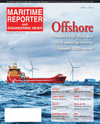
Page 57: of Maritime Reporter Magazine (April 2012)
Offshore Deepwater Annual
Read this page in Pdf, Flash or Html5 edition of April 2012 Maritime Reporter Magazine
technology matures, the potential is def-initely there. Models suggest we cansafely extract 2500 MW from the Minas Passage during peak flows ? and the peak electricity demand for the entire province in only 2300 megawatts. With this potential in mind, we have built capacity for growth into our electri- cal infrastructure. We have enough sub- marine cable capacity for 64 megawatts, which is like putting 64 commercial- scale turbines in the water. This means we have more capacity than any other tidal turbine site in the world. The province has also supported the idea of commercial growth by creating feed-in tariffs for tidal ? an effective way to incent development in the Bay of Fundy. The feed-in tariff has garnered the interest of every major tidal developer on the planet.What, currently, do you count as your Greatest Technological needs and chal- lenges to help you go about your daily work? For FORCE, one of our greatest needs is access to high quality, site-specific data. Developers, researchers, and regu- lators all want that data, and acquiring it in a high flow site like ours is challeng- ing.While the challenges of the region are ob- vious, what do you count as the top three operating challenges for traditional sub- sea equipment.The fundamental challenge is the ex- treme conditions at FORCE; this lies atthe center of a number of associatedchallenges: turbine installation and main-tenance, vessel access and mobilization time, and electronic equipment reliabil-ity and performance.While the challenges are indeed great, what do you see as the ultimate reward of your work? The FORCE site has been called theEverest of tidal. Everyone knows Ed- mund Hillary and Tenzing Norgay were the first to the top of the mountain. But they always said it was a team effort. Tidal electricity is a team effort too and FORCE is the advanced base camp. When we see technologies succeed here,and over time prove both their safety and economic viability, I believe FORCE will have played an historical role in the emergence of a new and clean energy technology. Better still, this technology has the potential to transform Nova Sco- tias electricity supply. This will take time ? and there wont be any shortcuts. Developers need time to refine their de- signs, and we need time to make sure we understand how this technology interacts with both the Bay of Fundy environment, and our electricity market. For this specific project, can you explain how government and industry work to- gether for a common end? Everyone sees the enormous opportu- nity for Nova Scotia and Canada. On the research side, we live in a province with more post-secondary institutions percapita than any other region in North America, and much of that work is cen- tered around ocean-related activity. In terms of industry, we have over 300 com- panies with years of experience supply- ing and servicing Nova Scotias offshore oil and gas projects: Cohasset, Sable, and more recently Deep Panuke ? and many of those companies work in the marine energy environment all over the world. Their skills are directly translatable tothe tidal industry. And theyve already been put to work: identifying the test site, monitoring the environment, towing equipment, building a gravity base, pio- neering new research. All of the turbine developers have sup- ply chain partners in Nova Scotia and Canada.There have been positive signals from April 2012www.marinelink.com 53

 56
56

 58
58
